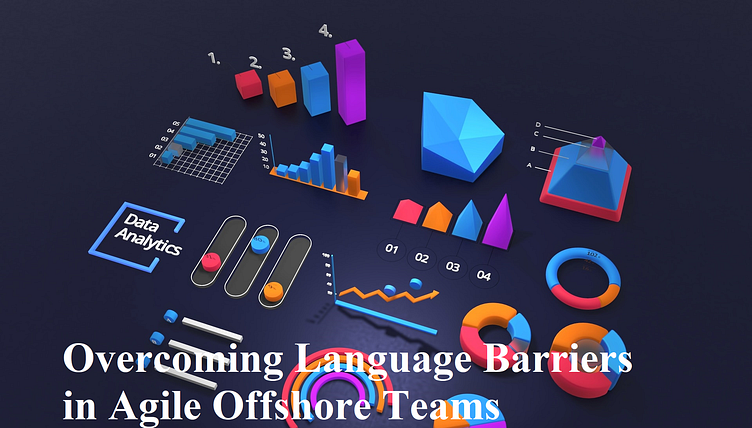Overcoming Language Barriers in Agile Offshore Teams
Agile offshore development has become a cornerstone of the modern software development landscape, offering cost-effective access to global talent and the ability to deliver software solutions rapidly. However, one significant challenge that Agile offshore teams often face is language barriers. Effective communication is the lifeblood of Agile methodologies, and when teams are spread across different countries and cultures, language differences can create roadblocks. In this in-depth blog post, we will explore the intricacies of overcoming language barriers in Agile offshore teams. We will delve into the challenges, strategies, best practices, real-world examples, and the pivotal role of technology in achieving seamless communication and collaboration.
The Significance of Effective Communication in Agile
Before diving into the nuances of language barriers in Agile offshore teams, it's crucial to understand why effective communication is paramount in Agile development.
Agile methodologies, including Scrum, Kanban, and Lean, place a strong emphasis on:
Collaboration: Agile teams work closely together, sharing ideas, knowledge, and expertise to achieve common goals.
Transparency: Open and honest communication ensures that everyone involved understands the project's status, challenges, and priorities.
Feedback: Frequent feedback loops allow teams to adapt and improve continuously.
Adaptability: Agile teams must be able to pivot quickly based on changing requirements and customer feedback.
Effective communication is the linchpin that holds these principles together. When language barriers hinder communication, it can lead to misunderstandings, misaligned expectations, and ultimately, project delays and failures.
The Multifaceted Challenges of Language Barriers
Language barriers in Agile offshore teams can manifest in various ways, making communication more challenging:
1. Verbal Communication
Mispronunciations, misunderstandings, and misinterpretations can arise during verbal communication, especially when team members speak different native languages or dialects.
2. Written Communication
Emails, chat messages, and documentation can be riddled with grammatical errors and misunderstandings, leading to confusion.
3. Cultural Differences
Cultural norms, idiomatic expressions, and communication styles can vary greatly between countries, adding complexity to interactions.
4. Time Zone Variations
Teams working in different time zones may struggle to find overlapping working hours for real-time communication.
5. Lack of Confidence
Language barriers can erode team members' confidence in expressing ideas or asking questions, inhibiting collaboration.
6. Misalignment
Misaligned expectations and differing interpretations of project requirements can lead to rework and project delays.
Strategies for Overcoming Language Barriers in Agile Offshore Teams
Effective communication is the linchpin that holds Agile offshore teams together. To overcome language barriers and ensure seamless collaboration, consider the following strategies:
1. Common Language
Select a common language for communication within the team. English is often chosen as it is widely spoken and understood globally. Ensure that all team members have a reasonable proficiency in the chosen language.
2. Clear Documentation
Emphasize the importance of clear and concise documentation. Use visual aids, diagrams, and charts to supplement written and verbal communication. Documentation should be accessible to all team members.
3. Cultural Sensitivity
Promote cultural awareness and sensitivity within the team. Encourage open discussions about cultural differences and norms to foster understanding and respect.
4. Language Training
Invest in language training for team members who need to improve their language skills. Language courses, workshops, and resources can enhance communication proficiency.
5. Visual Communication
Leverage visual communication tools and techniques, such as storyboards, flowcharts, and wireframes, to convey ideas and concepts visually.
6. Tools and Technology
Utilize collaboration tools and technology platforms that support multilingual communication. Video conferencing, instant messaging, and translation software can aid in bridging language gaps.
7. Frequent Check-Ins
Schedule regular check-in meetings to allow team members to ask questions, seek clarification, and address concerns. Frequent communication helps prevent misunderstandings from snowballing.
8. Clear Roles and Responsibilities
Define clear roles and responsibilities for team members to avoid ambiguity. Ensure that everyone understands their tasks and responsibilities.
9. Agile Training
Provide Agile training to team members to ensure a shared understanding of Agile principles, practices, and terminology. This can help align the team's approach to Agile methodologies.
Real-Life Examples of Overcoming Language Barriers
1. IBM's Multinational Teams
IBM, a global technology company, operates in numerous countries with diverse language backgrounds. To overcome language barriers, they utilize a combination of a common language (English), translation tools, and clear documentation. Regular cross-team communication and cultural sensitivity training also play a crucial role in facilitating effective communication.
2. Spotify's Collaborative Culture
Spotify, the popular music streaming service, operates Agile teams in multiple countries. They prioritize a collaborative culture that values openness and transparency. Team members are encouraged to speak up, ask questions, and express concerns without fear of language-related judgments.
The Role of Technology in Bridging Language Barriers
In the digital age, technology plays a pivotal role in overcoming language barriers in Agile offshore teams. Here's how technology can help:
1. Translation Tools: Use translation software and tools to facilitate real-time translation of written and spoken communication.
2. Collaboration Platforms: Leverage collaboration platforms that offer multilingual support, making it easier for team members to communicate effectively.
3. Video Conferencing: Video conferencing platforms enable face-to-face communication, allowing team members to rely on visual cues and body language.
4. Agile Project Management Tools: Use Agile project management tools that provide multilingual interfaces and support Agile practices, making it easier to manage projects effectively.
5. Language-Specific Training: Invest in e-learning platforms that offer language-specific Agile training modules to improve team members' language proficiency.
Conclusion
Language barriers in Agile offshore teams are a challenge but not an insurmountable one. With the right strategies, cultural sensitivity, training, and technology, organizations can bridge the language divide and foster effective communication and collaboration.
Effective communication is the cornerstone of Agile methodologies, and by addressing language barriers head-on, organizations can ensure that their Agile offshore teams work cohesively, deliver value efficiently, and achieve project success. The ability to overcome language barriers not only strengthens teams but also enhances the global reach and impact of Agile offshore software development outsourcing company in an increasingly interconnected world.
